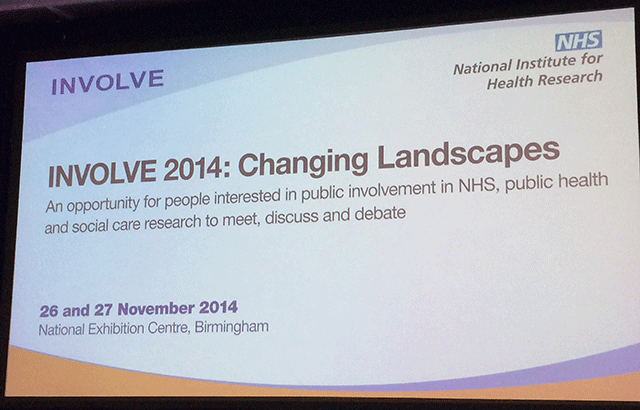What’s in a name? – Reflections from INVOLVE 2014

Written by Bryony Frost,
Public Engagement Officer at the Centre for Public Engagement
At Queen Mary we use the word ‘public engagement’ as a catch-all term, encompassing any process or activity in which researchers interact with people outside of the university – from patients to politicians. I like this. It means that we take a really holistic approach, supporting people new to engagement that want to do something small (update their website to be more accessible, set up a blog) and working right through to collaborative research projects (collaborating between disciplines as well as between the public and researchers).
Simon Gaskell, Principal and President of QMUL, talks of a spectrum describing activities which are ‘academically desirable’, running from knowledge creation to knowledge dissemination. Just as teaching and research can sit at different points on the spectrum, so too do different types of public engagement. One-way lectures, websites and media sit at one end, with two-way research done in partnership with non-academics at the other end – with lots of activity in between. It isn’t a spectrum from good to bad, just a way of demonstrating how the many activities we call engagement fit together.
Our ‘spectrum of activity’ approach means that we get to know everyone who is interested in anything public facing, so when they want to do something in a different part of the spectrum, we are there to help. It also means we can advocate for reward and recognition – it is a lot easier to get ‘public engagement’ in the promotion criteria than school outreach and policy work and collaborative research and digital engagement and so on.
Other institutions and research funders broadly agree – while some places separate out ‘media work’ or ‘outreach’, most concur that public engagement definitely has a two-way element, involving the public in the research process.
INVOLVE (the body set up by the National Institute of Health Research to support active public involvement in NHS, public health and social care research) use a different approach. They are only interested in what they call involvement - research being carried out ‘with’ or ‘by’ members of the public rather than ‘to’, ‘about’ or ‘for’ them. This isn’t a bad thing – in health in particular real involvement with research has obvious, powerful advantages, and it is essential it is supported.
What I struggle with is the way they split patient-facing activity into three areas:
• Participation – where people take part in a research study
• Involvement – where members of the public are actively involved in research projects and in research organisations
• Engagement – where information and knowledge about research is provided and disseminated
It’s the usage of the word ‘engagement’ to mean dissemination that worries me. INVOLVE describe engagement activities as things like open days, media work and dissemination of study results. That is difficult for me, because I quite often have to fight the image that engagement is ‘just’ dissemination, and broaden people’s understanding of the word. We work closely with the NCCPE (National Coordinating Centre for Public Engagement) and RCUK who both define ‘public engagement’ as a two-way process: INVOLVE’s definition describes engagement as exactly the opposite.
So – does it matter? I think so. There are enough barriers to engaging with this agenda (for both researchers and the ‘public’) without confusing matters by using different language. To have the worlds of university public engagement and health research involvement using the word engagement to mean almost opposite things doesn’t seem helpful – and certainly is something university engagement practitioners need to be aware of when talking to their medical schools. I’m not sure what to do about it, but I do think making sure that people working in the fields know that this issue of definitions exists means we can and should adjust the way we talk to reduce confusion.
Unless engolvement is a good compromise?
By Bryony Frost
Public Engagement Officer
Queen Mary University of London